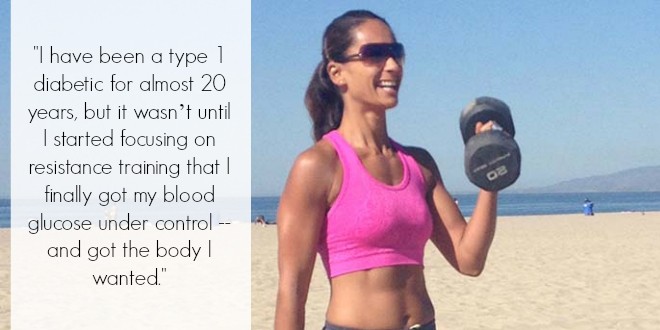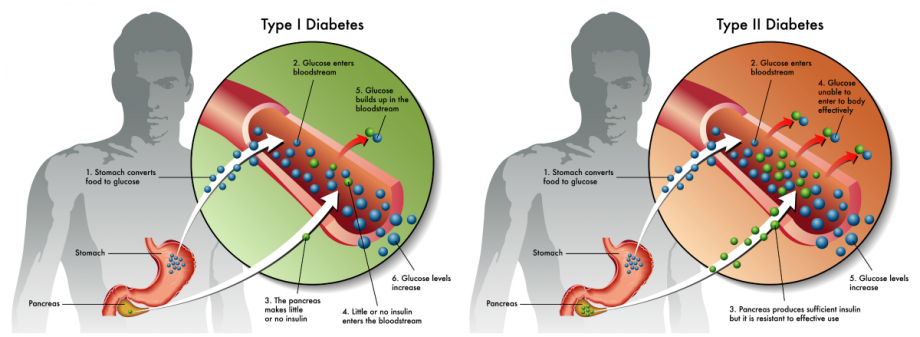Why People Living With Diabetes Need Strength Training

 If you live with diabetes
, you have probably been told more times than you care to count how important aerobic training (walking, running, etc.) is for your health.
However, a lot of people with diabetes, who I meet through my job as a personal trainer, don’t realize that resistance training ( lifting weights
) can also be a huge help with regulating their blood glucose and weight.
If you live with diabetes
, you have probably been told more times than you care to count how important aerobic training (walking, running, etc.) is for your health.
However, a lot of people with diabetes, who I meet through my job as a personal trainer, don’t realize that resistance training ( lifting weights
) can also be a huge help with regulating their blood glucose and weight.I have been a type 1 diabetic for almost 20 years, but it wasn’t until I started focusing on resistance training that I finally got my blood glucose under control (and got the body I wanted).
Why resistance training is more effective than cardio in the long-term
While cardiovascular exercise is great for burning calories and regulating blood glucose, it doesn’t help you build much lean muscle mass, which permanently raises your metabolism, and raising your metabolism is really the name of the game when it comes to long-term blood glucose (and weight) management.

Not only does muscle burn more calories than fat (so the more muscle mass you have, the more calories you burn, even when doing nothing!), but it also much improves insulin sensitivity. This means, that as you build muscle mass, you will most likely see a reduction in your insulin needs.
When you need less insulin, it also becomes easier to manage stable blood sugars. If you then combine this stability with a healthy, low glycemic diet , you have a winner with regards to control of your diabetes.
[tweet_box design="box_12"]Approximately 90% of all cases of diabetes worldwide are type 2.[/tweet_box]
I always recommend that clients start building muscle by spending most of their energy doing resistance training , while holding back on traditional cardiovascular exercises. Depending on the person and his or her goals, that might mean two to three 1-hour resistance training sessions per week, while only doing cardiovascular exercises for 20-30 minutes, twice per week.
As a Diabetic You need to be ready
Living with type 1 diabetes or insulin dependent diabetes in general, means that you can’t just “jump into it” and expect to be successful. You need to make a plan and be mindful of how your blood sugars will react to different kind of exercise.
For most people living with insulin dependent diabetes, cardiovascular exercise will make your blood sugars drop while you workout, and then stabilize shortly afterwards. Resistance training on the other hand, will often make your blood sugars rise while working out and then drop over the next 24 hours . This means, that when you start a new routine, you need to carefully watch how you body reacts, so that you don’t experience severe hypoglycemia or hyperglycemia.
Additional information about Diabetes
[box type="info" align="" class="" width=""]
The following exert is from Medical News Today
What is Type 1 Diabetes?
The body does not produce insulin. Some people may refer to this type as insulin-dependent diabetes , juvenile diabetes , or early onset diabetes . People usually develop type 1 diabetes before their 40th year, often in early adulthood or teenage years.
Type 1 diabetes is nowhere near as common as type 2 diabetes. Approximately 10% of all diabetes cases are type 1.
Patients with type 1 diabetes will need to take insulin injections for the rest of their life. They must also make sure proper blood-glucose levels by carrying out regular blood tests and following a special diet.
Between 2001 and 2009, the prevalence of type 1 diabetes among the under 20s in the USA rose 23%, according to SEARCH for Diabetes in Youth data issued by the CDC (Centers for Disease Control and Prevention). (Link to article)
What is Type 2 Diabetes?
The body does not produce enough insulin for proper function, or the cells in the body do not react to insulin (insulin resistance).
[caption id="attachment_19847" align="aligncenter" width="601"]
 Type 1 versus Type 2 Diabetes[/caption]
Type 1 versus Type 2 Diabetes[/caption][/box]
A few recommendations to consider as a diabetic
I recommend using something as low tech as a notebook. Take note of what you eat, how much you eat, what your blood sugar readings are, and the type and duration of your workouts. If you do this for about a week, you should have enough data to be able to manage both the diabetes and your workouts. You can read more about how to manage food and insulin around workouts here.
If you haven’t already incorporated resistance training into your workout routine, I really hope you will give it a try. Besides the health benefits described above, I also find that being stronger and fitter helps me feel empowered and boost my confidence.
In my next guest post here on The Moose Is Loose, I’ll provide you with a full sample resistance training workout, so you can get started.
[tweet_box design="box_12"]If you're Type 1 diabetic and follow a smart eating plan, exercise, and take insulin, you can lead a normal life.[/tweet_box]
[box type="shadow" align="" class="" width=""]
Peter Attia asks a powerful question in his TedTalk "Is the obesity crisis hiding a bigger problem?"
https://youtu.be/sjJrXHWLP_M
[/box]
[divider style="dashed" top="15" bottom="15"]
 Author Bio: Christel Oerum
Author Bio: Christel Oerum
Christel writes the fitness blog TheFitBlog.com together with her husband. Here she blogs about health, fitness, and how to be Fit With Diabetes. If you want to take your health and fitness to the next level, you can download her Female Fitness Program. Follow Christel on TheFitBlog and/or Facebook. You can also email her directly at Christel@Thefitblog.com




































































































